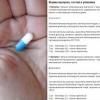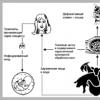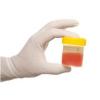Rheumatoid arthritis. Rheumatoid arthritis: clinical guidelines Get treatment in Korea, Israel, Germany, USA
About 2% of the world's population of working age is affected by this disease. At the same time, rheumatoid arthritis “attacks” women more often than the strong half of humanity. Due to such a significant prevalence of the disease and the severity of the disease, there was a need for a standard of diagnosis and treatment that could be used by rheumatologists around the world. Accordingly, "Clinical Guidelines" were created. This is a rather voluminous document, consisting of several sections, which are designed to unify approaches to the definition, treatment, and prevention of the disease.
In our country, doctors rely on the "Federal clinical guidelines”, which were approved by the Association of Russian Rheumatologists in October 2013.
Recommendations for the treatment of rheumatoid arthritis (RA) consist of the following sections:
- classification of the disease;
- methods for diagnosing and distinguishing RA from other joint ailments;
- treatment.
Let's take a closer look at each of the chapters.
Today, experts suggest considering a number of varieties of RA. In addition to seropositive and seronegative, rheumatoid arthritis also includes such specific clinical forms like Felty's syndrome, Still's disease and probable RA. All of them have their own indexes in international classification diseases.
The document distinguishes 4 clinical stages of the course of the disease - from very early, which began less than six months ago, to late, in which the disease lasts longer, and has already affected large and small joints, gave complications to many internal organs.
Several types of disease activity are also considered - from remission to high activity. Indicators of the level of process activity are given, which are denoted by the abbreviation DAS.
Another item listed in the classification section is extra-articular manifestations that help distinguish RA from other joint diseases, such as osteoarthritis, rheumatic fever, gout, bacterial endocarditis, reactive, septic, viral and psoriatic arthritis, ankylosing spondylitis.
Clinical guidelines for rheumatoid arthritis describe in detail the systemic manifestations of the disease in the body, which can tell the doctor the presence of RA in a patient. These include:
- eye damage;
- rheumatoid nodules near the joint;
- neuropathy (nerve damage of a non-inflammatory nature);
- pericarditis (inflammation of the lining of the heart);
- vasculitis (inflammation of blood vessels);
- pleurisy (inflammation of the pleura);
- Sjögren's syndrome, which affects the lacrimal and salivary glands.
The document explains in detail how a person is able to work and self-care in each of the four functional classes of RA, and what are the numerous complications of the disease.
An extensive section of the 2017 clinical guidelines for rheumatoid arthritis is devoted to the nuances of diagnosis. Depending on the type and activity of the disease (which is calculated using special formulas), the patient is prescribed various analyzes And diagnostic measures. Of course, at first they carefully listen to him and probe, in the literal sense of the word, his joints. Considerable assistance to the attending physician is provided by the recommendations developed by the American Association of Rheumatologists. 7 points are proposed, according to which, already at the first visit, it is possible to make an appropriate diagnosis. In this case, it is enough for the patient to recognize 4 points from himself. These may include:
- arthritis of three or more joints;
- stiffness in the morning;
- swollen joints of any of the groups of joints on the hands;
- the presence of subcutaneous nodules;
- inflammation of symmetrical joints;
- the results of the radiograph should show changes characteristic of the disease;
- increased titers of rheumatoid factor in the blood.
For an accurate diagnosis, it is also necessary to pass a number of laboratory tests and undergo any type of hardware diagnostics. You will have to donate blood for the following tests:
- general;
- biochemical;
- clinical;
- immunological.
To see the state of the joint, you will need:
- radiograph;
- Doppler ultrasonography;
To determine if rheumatoid arthritis has affected other organs, the patient undergoes:
- echocardiogram (will help to identify the effect of the disease on the heart);
- CT (lungs look);
- biopsy (if amyloidosis is suspected).
Such a comprehensive diagnosis is designed to exclude similar diseases and determine the degree of damage to the body.
The treatment is carried out by a rheumatologist, if necessary, an oculist, a cardiologist, an orthopedist, a neuropathologist, a physiotherapist, a psychologist are involved. Their efforts are aimed at achieving remission and maintaining it for as long as possible. Unfortunately, there is no cure for rheumatoid arthritis.
Recommendations for rheumatoid arthritis include drug and non-drug treatments.
The earlier a person turns to doctors, the more likely it is to return the joints to the most healthy and mobile state. Although they will not become the same as in their youth. However, the absence of pain, inflammation and good mobility are also important factors.
According to indications and general state of health, a person can be prescribed:
- non-steroidal anti-inflammatory;
- glucocorticosteroids;
- means of improving the state of immunity.
Specific names and dosages are determined by the doctor.
Non-drug means are:
- reduction in body weight;
- rejection of bad habits;
- performing physical therapy exercises;
- balanced diet;
- physiotherapy procedures.
Only an integrated approach will help reduce the destructive effect of arthritis on the joints and the body as a whole.
Rheumatoid arthritis- heavy autoimmune disease joints. Clinical recommendations for diagnosis, treatment, rehabilitation and prevention.
Rheumatoid arthritis is a rheumatic autoimmune disease, the causes of which remain unknown to modern medicine.
Pathology is manifested by chronic erosive arthritis and systemic damage internal organs.
All this often causes early disability and shortened life expectancy of patients.
RA diagnoses according to the ICD-10 classification:
Consider what rheumatoid arthritis is, clinical guidelines for its diagnosis and treatment.
↯ More articles in the journal
The main thing in the article
The manifestation of the disease is variable. Most often, it begins with polyarthritis, in more rare cases, the signs of arthritis can be mild, but the following symptoms predominate:
- pain and stiffness in the joints,
- worsening general condition;
- weakness, fatigue;
- weight loss;
- temperature rise to subfebrile values;
- swollen lymph nodes.
All this may precede clinically pronounced joint damage.
- skin;
- muscle corset;
- bronchopulmonary system;
- of cardio-vascular system;
- urinary system;
- endocrine system.
Grade appearance the patient can identify:
- Deficiency in body weight.
- Hyperhidrosis.
- Generalized amyotrophy.
- Inflammation of the mucous membrane of the eyes.
- Lymphadenitis, lymphadenopathy.
- Skin pathologies - rheumatoid nodules, thickening, hypotrophy.
- Digital arteritis, sometimes with the development of gangrene of the fingers.
- Microinfarcts in the area of the nail bed.
Rheumatoid arthritis is characterized by symmetrical multiple lesions of the small joints of the feet and hands.
With an acute onset and active inflammation, periarticular osteoporosis and single cysts are detected within a month from the onset of the pathological process, while multiple cysts, narrowing of the joint spaces and single erosions are detected only after 3-6 months from the onset of the disease, especially in the absence of therapeutic measures.
It is not recommended to take basic anti-inflammatory drugs in patients with RA who have previously had non-melanoma skin cancer or have a history of solid tumors. genetic engineering biological preparations in this case should be applied with great care.
It is also undesirable to take hydroxychloroquine, sulfasalazine, rituximab, TNF-a inhibitors in patients with rheumatoid arthritis with a history of lymphoproliferative diseases - chronic lymphocytic leukemia, hairy cell leukemia, extramedullary tumors, etc. Other DMARDs and genetically engineered biologics are prescribed to such patients with caution.
Side effects of treatment with genetically engineered biological drugs
GIBD therapy is enough safe method treatment, although in some cases various undesirable (up to severe) reactions are possible that require careful monitoring - systemic immune reactions, hypersensitivity reactions (including anaphylaxis), severe infections(including latent tuberculosis infection), as well as local reactions with subcutaneous administration of the drug.
☆ Standard for Primary Health Care for Rheumatoid Arthritis. Medical events for diagnosing a disease in the Consilium System.
Download table
Treatment tactics after achieving remission
A gradual, carefully controlled dose reduction or withdrawal of GIBAs is possible if a stable remission is achieved after the withdrawal of glucocorticoids or if they continue to be taken at a dose of less than 5 mg per day.
Cancellation of genetically engineered drugs is more likely in patients with early RF/ACCP-negative rheumatoid arthritis.
In some cases, against the background of the cancellation or reduction of the dosage of genetically engineered biological products, the patient develops an exacerbation, which requires immediate re-appointment of the same or other GEBDs.
As a rule, this measure leads to a rapid suppression of inflammation activity in most patients.
An exacerbation against the background of discontinuation of GEBAs or a decrease in their dose most often develops with an advanced RF/ACCP-positive variant of rheumatoid arthritis.
The attending physician should consider reducing the dose or discontinuing standard DMARDs when long-term stable remission is achieved after completion of treatment with genetically engineered drugs.
In patients with an advanced form of the disease, the abolition of basic drugs usually provokes an exacerbation, and therefore is not recommended.
Surgery
Surgical treatment of rheumatoid arthritis is carried out in a traumatological and orthopedic hospital.
Indications for it:
- Synovitis resistant to drug treatment.
- Joint deformities, violation of their functions.
- Chronic pain syndrome.
Types of surgical treatment:
- arthroscopic and open synovectomy;
- debridement;
- osteotomy;
- osteoplasty;
- joint arthroplasty.
Surgical intervention leads to an improvement in the functional abilities of the patient in the medium term.
In the perioperative period, patients with rheumatoid arthritis are treated with cytostatics, in particular, methotrexate.
Its cancellation can provoke an exacerbation of RA in postoperative period and significantly worsen the results of the intervention. A contraindication to the use of methotrexate is only the presence of severe renal pathologies in the patient.
Before surgery, treatment with genetically engineered biological products is interrupted for a time depending on their pharmacokinetic properties.
The term for stopping treatment depends on:
- half-life of drugs - 3-5 times longer than their half-life;
- individual characteristics of the patient;
- the nature of the upcoming operation.
Therapy is resumed if there is no information about the presence of infection, and the surgical wound surface heals and is in a satisfactory condition.
Hormone therapy continues in the postoperative period at the same dosage. On the day of surgery, a patient with rheumatoid arthritis is shown the appointment of replacement therapy (in / in the infusion of hydrocortisone 25-100 mg or 6-MPRED - 5-30 mg, depending on the severity of the intervention).
Rheumatoid arthritis is an autoimmune disease characterized by the presence of chronic inflammatory processes in the joints, disorders in the functioning of all body systems. It is one of the causes of early disability: both in adulthood and childhood. Only the consequences of the disease can be improved timely diagnosis and treatment.
Causes, types
The mechanism of development of this disease is not fully understood. It is believed that inflammation of the joints is a consequence of a long-term disruption in work. immune system. Factors that provoke the appearance of immune pathologies and the development of rheumatoid arthritis include:
- long stay in the cold;
- frequent stress, emotional exhaustion;
- joint injuries;
- infectious diseases(rheumatoid arthritis can occur after a sore throat, flu, cold).
The disease develops slowly and imperceptibly for the patient. He can lead his usual way of life and feel normal, but there may already be cells in his body that cause rejection of his own tissues. Inflammation of the joints, their deformation occurs when a large amount of antibodies has accumulated in the body.
There are several forms of rheumatoid arthritis. The classification of the disease is carried out according to the following criteria:
The nature of the flow:
- sharp;
- subacute.
Type of lesion (types):
- systemic arthritis;
- oligo- and polyarthritis.
Place of occurrence of pathological processes, forms of the disease:
- articular;
- visceral-articular (affects the joints, organs).
Development speed:
- slowly progressive;
- moderately and rapidly progressive.
People over the age of 40 are most likely to develop rheumatoid arthritis. But the development of the disease is also possible in patients of a younger age category. If inflammation and destruction of the joints are detected in patients under the age of 16 years, the diagnosis is "juvenile rheumatoid arthritis". The manifestation of the disease in children, clinical recommendations for its treatment are the same as in adults.
Features of manifestation
The disease manifests itself in different ways. The clinical picture of rheumatoid arthritis depends on:
- stages of the disease;
- localization of inflammatory and destructive processes;
- severity of joint damage;
- presence of complications.
With a latent course of the disease, the patient complains of:
- chronic fatigue;
- muscle weakness;
- rapid weight loss;
- excessive sweating;
- unreasonable increase in body temperature (mainly in the morning);
For subacute rheumatoid arthritis, the appearance of pain is characteristic. The patient is disturbed aching pain in the area of inflamed joints. Their intensity is highest in the evening. It is possible to reduce the severity of pain sensations only through the use of NSAIDs.
involved in inflammatory processes different types joints. But the most commonly affected are those that are responsible for the mobility of the knees, fingers and wrists. Sometimes there is inflammation of the tissues of the shoulders, hips, spinal column.
| Inflammation of the joints in arthritis | Characteristic symptoms |
| Carpal, interphalangeal | Swelling of tendons located near the affected joints |
| Disturbance of mobility of the hand | |
| Difficulty making a fist | |
| Decreased sensitivity of the first three fingers | |
| Elbow, radioulnar | Elbow pain |
| Deterioration of joint mobility (especially after a long stay in one position) | |
| Shoulder | Weight loss, dysfunction of the muscles of the neck, shoulders and collarbone |
| Elevated body temperature in the lesion | |
| Tissue swelling | |
| Limitation of joint mobility | |
| Ankle | Displaced toes |
| Leg pain walking, running | |
| Change in gait | |
| knee | Dysfunction of the quadriceps muscle |
| Decreased mobility in the knee | |
| Protrusion of intra-articular fluid into the popliteal fossa | |
| Hip | Pain radiating to the groin |
| Intermittent claudication | |
| Necrosis of the femur | |
| Joints of the cervical spine | Discomfort, pain in the neck, arm and shoulder area |
| Headaches | |
| Crunch, displacement of the cervical vertebrae | |
| Neck muscle stiffness |
This diagram shows two joints - healthy and damaged. Check it out carefully.
In rheumatoid arthritis, the joints are first affected. But if the disease progresses, the work of such body systems is disrupted:
digestive. Associated symptoms of arthritis:
- loss of appetite;
- flatulence;
- pain in the stomach, lower abdomen.
Cardiovascular:
- inflammation of the pericardial sac;
- granulomatous lesions of the heart valves (rarely observed);
- atherosclerosis.
urinary. Signs of progressive rheumatoid arthritis:
- glomerulonephritis;
- amyloidosis;
- kidney failure.
nervous. Rheumatoid arthritis is characterized by:
- decreased sensitivity at the site of injury;
- the occurrence of cervical myelitis, paralysis;
- violation of heat transfer processes.
hematopoietic:
- anemia
- deviation of blood parameters from the norm (decrease in the number of platelets, leukocytes).
Respiratory. Manifestations of a systemic autoimmune disease:
- damage to the lungs with rheumatoid nodules (Kaplan's syndrome);
- bronchiolitis.
visual:
- conjunctivitis;
- episcleritis;
- keratitis.
If you experience signs of rheumatoid arthritis, you should consult a doctor. Only a specialist can determine the cause of deterioration of health, choose the right treatment.
The diagnosis can be confirmed only after a comprehensive examination of the patient. To exclude the presence of other diseases, the following diagnostic methods are used:
Laboratory. These include:
- blood test (general, advanced);
- test for antibodies to cyclic citrulline peptide - allows you to detect arthritis at an early stage of its development (in the presence of the disease in 90% of cases, the test results are positive);
- study of synovial fluid.
Instrumental. If rheumatoid arthritis is suspected:
- radiography - helps to determine the stage of the disease, to assess the extent of the spread of inflammatory processes in the joints;
- fluorography - is performed when you need to find out if the patient has a pathology of the respiratory system;
- MRI, CT are the most informative diagnostic methods;
- echocardiography - indicated in the presence of symptoms of disorders of the heart;
- arthroscopy - allows you to distinguish clinical manifestation rheumatoid arthritis from signs of osteoarthritis, villous-nodular synovitis, traumatic joint damage;
- biopsy - performed if amyloidosis is suspected.
Therapy of the disease should be comprehensive and include: taking medications, the use of auxiliary methods to combat pathology. At drug treatment appoint:
- Non-steroidal anti-inflammatory drugs - reduce inflammation, relieve pain, but do not affect the prognosis of the disease. NSAIDs can cause negative reactions from digestive system. Therefore, their use in rheumatoid arthritis is limited.
- Basic anti-inflammatory drugs - shown to all patients. In rheumatoid arthritis, they are used as early as possible: within 3 to 6 months from the onset of the disease.
- Glucocorticoids - are used together with DMARDs (before the onset of the effect of their administration) to stop the exacerbation of the disease. With the low effectiveness of anti-inflammatory drugs or the impossibility of their use, these drugs are prescribed as an independent therapy.
Non-drug treatments for rheumatoid arthritis include:
- classes therapeutic gymnastics(at least 2 times a week);
- physiotherapy (exposure to cold, heat, laser and ultrasound);
- massage procedures;
- spa treatment (recommended for remission).
With a complicated course of the disease, they resort to surgery. Indications for emergency surgery:
- subluxation of the cervical vertebrae, accompanied by neurological complications;
- joint deformities that make it difficult to perform simple movements;
- tendon ruptures;
- severe ankylosis, dislocation of the lower jaw;
- pinched nerve at the site of joint damage;
- accumulation of a large amount of fluid in the articular bags.
During the treatment period, the patient must:
- Avoid factors that provoke an exacerbation of the disease. These include: infectious diseases, frequent stress.
- Quit smoking, drinking alcohol.
- Control body weight.
- Eat a balanced diet. The diet should include foods high in polyunsaturated fatty acids: fresh fruits and vegetables olive oil, fish fat.
Patients with rheumatoid arthritis should follow clinical guidelines for treatment. Otherwise, it threatens with the occurrence of atherosclerosis, secondary osteoarthritis and systemic amyloidosis, instability of the cervical spine.
With timely treatment to the doctor, the prognosis for recovery is favorable. If the therapy is chosen correctly, a year after the start of treatment, it is possible to achieve a stable remission of rheumatoid arthritis. The most significant progress is achieved in the period from 2 to 6 years of illness: inflammatory processes stop.
Other arthritis (M13), Other rheumatoid arthritis (M06), Seropositive rheumatoid arthritis (M05)
Rheumatology
general information
Short description
All-Russian public organization Association of Rheumatologists of Russia
Clinical recommendations "Rheumatoid arthritis" passed the public review, agreed and approved on October 5, 2013, at a meeting of the Plenum of the Board of the RDA, held jointly with the profile commission of the Ministry of Health of the Russian Federation in the specialty "rheumatology". (President of the RDA, Academician of the Russian Academy of Sciences - E.L. Nasonov)
Rheumatoid arthritis (RA)- an autoimmune rheumatic disease of unknown etiology, characterized by chronic erosive arthritis (synovitis) and systemic damage to internal organs. The prevalence of RA among the adult population is 0.5-2% (in women 65 years old, about 5%). The ratio of women to men is 2-3:1. All age groups are affected, including children and the elderly. The peak onset of the disease is 40-55 years. Screening is not performed. RA is characterized by a variety of variants of the onset of the disease. In most cases, the disease begins with polyarthritis, less often with mono- and oligoarthritis, sometimes manifestations of arthritis can be moderately expressed, and arthralgia, morning stiffness in the joints, deterioration in general condition, weakness, weight loss, low-grade fever, lymphadenopathy, which may precede clinically pronounced joint damage.
Classification
Clinical classification of RA
Classification of rheumatoid arthritis (adopted at the meeting of the Plenum of the Association of Rheumatologists of Russia on September 30, 2007)
1. Main diagnosis:
1. Seropositive rheumatoid arthritis (M05.8)
2. Seronegative rheumatoid arthritis (M06.0)
3. Special clinical forms of rheumatoid arthritis:
- Felty syndrome (M05.0)
- Adult-onset Still's disease (M06.1)
4. Probable rheumatoid arthritis (M05.9, M06.4, M06.9)
2. Clinical stage:
1. Very early stage: duration of illness< 6 месяцев
2. Early stage: disease duration 6 months. - 1 year
3. Advanced stage: disease duration > 1 year with typical RA symptoms
4. Late stage: the duration of the disease is 2 years or more + severe destruction of small (III-IV X-ray stage) and large joints, the presence of complications
3. Disease activity:
1. 0 = remission (DAS28< 2,6)
2. 1 = low (2.6< DAS28 <3,2)
3. 2 = medium (DAS28 3.2 - 5.1)
4. 3 = high (DAS28 > 5.1)
4. Extra-articular (systemic) manifestations:
1. rheumatoid nodules
2. cutaneous vasculitis (necrotizing ulcerative vasculitis, nail bed infarcts, digital arteritis, livedoangiitis)
3. vasculitis of other organs
4. neuropathy (mononeuritis, polyneuropathy)
5. pleurisy (dry, effusion), pericarditis (dry, effusion)
6. Sjögren's syndrome
7. eye damage (scleritis, episcleritis, retinal vasculitis)
5. Instrumental characteristic:
1. The presence of erosions (using radiography, possibly MRI, ultrasound):
- non-erosive
- Erosive
2. X-ray stage (according to Steinbroker, modification):
I - periarticular osteoporosis
II - osteoporosis + narrowing of the joint space, there may be single erosions
III - signs of the previous stage + multiple erosions + subluxations in the joints
IV - signs of the previous stage + bone ankylosis
6. Additional immunological characteristic - anticitrulline antibodies:
1. ACCP - positive
2. ACCP - negative
7. Functional class:
I - fully preserved: self-service, non-professional and professional activities
II - retained: self-service, professional activities, limited: non-professional activities
III - retained: self-service, limited: non-professional and professional activities
IV - limited: self-service, non-professional and professional activities
8. Complications:
1. secondary systemic amyloidosis
2. secondary arthrosis
3. osteoporosis (systemic)
4. osteonecrosis
5. tunnel syndromes(carpal tunnel syndrome, compression syndromes of the ulnar, tibial nerves)
6. subluxation in the atlanto-axial joint, including with myelopathy, instability of the cervical spine
7. atherosclerosis
Comments on the RA Classification:
1. To the heading "Main diagnosis":
Seropositivity and seronegativity are determined by a test for rheumatoid factor, which must be carried out using a reliable quantitative or semi-quantitative test (latex test, enzyme immunoassay, immunonephelometric method).
Where NPJ is the number of painful joints, NPJ is the number of swollen joints out of the following 28: shoulder, elbow, wrist, metacarpophalangeal, proximal interphalangeal, knee,
ESR - erythrocyte sedimentation rate according to the Westergren method,
OOSZ - a general assessment of the patient's state of health in mm on a 100 mm visual analogue scale
B) It is acceptable to use other methods for calculating activity, for which good comparability with DAS28 has been proven
2. To rubric 5 "Instrumental characteristics":
A detailed description of the radiological stages:
1 stage. Minor periarticular osteoporosis. Single cystic enlightenment of bone tissue. Slight narrowing of the joint spaces in individual joints.
2 stage. Moderate (pronounced) periarticular osteoporosis. Multiple cystic enlightenments of the bone tissue. Narrowing of joint spaces. Single erosions of articular surfaces (1-4). Minor bone deformities.
3 stage. Moderate (pronounced) periarticular osteoporosis. Multiple cystic enlightenments of the bone tissue. Narrowing of joint spaces. Multiple erosions of the articular surfaces (5 or more). Multiple pronounced bone deformities. Subluxations and dislocations of joints.
4 stage. Moderate (pronounced) periarticular (common) osteoporosis. Multiple cystic enlightenments of the bone tissue. Narrowing of joint spaces. Multiple erosions of bones and articular surfaces. Multiple pronounced bone deformities. Subluxations and dislocations of joints. Single (multiple) bone ankylosis. Subchondral osteosclerosis. Osteophytes on the edges of the articular surfaces.
3. To rubric 7 - Description of characteristics for determining the functional class:
· Self service: dressing, eating, personal care, etc.
· Non-professional activities: elements of recreation, leisure, sports, etc., taking into account gender and age
· Professional activity
: work, study, housekeeping (for domestic workers), taking into account gender and age.
Wording examples clinical diagnoses:
Seropositive rheumatoid arthritis (M05.8), advanced stage, activity II, erosive (X-ray stage II), with systemic manifestations (rheumatoid nodules), ACCP (-), FC II.
Rheumatoid arthritis, seronegative (M06.0), early stage, activity III, non-erosive (X-ray stage I), ACCP (+), FC I.
Seropositive rheumatoid arthritis (M05.8), late stage, erosive (X-ray stage III), activity II, with systemic manifestations (rheumatoid nodules, digital arteritis), ACCP (? - not studied), FC III, complications - carpal tunnel syndrome on the right, secondary amyloidosis with kidney damage.
Probable rheumatoid arthritis (M06.9), seronegative, early stage, activity II, non-erosive (X-ray stage I), ACCP (+), FC I.
Diagnostics
Diagnostic criteria and differential diagnosis of RA
Patients with new-onset inflammatory joint disease include:
Very early RA - a condition with a duration of symptoms of 3-6 months (potentially reversible condition)
Early RA, or "early established RA" - the first 1-2 years of the disease (when the first signs of disease progression can be determined, such as the presence or absence of a typical erosive process in the joints)
Undifferentiated arthritis (currently the term "undifferentiated peripheral arthritis" - NPA is used) - an inflammatory lesion of one or joints that cannot (at the moment) be attributed to any specific nosological form, that is, does not meet the classification criteria for RA or any other disease. About 1/3 of NPA patients develop RA within 1 year of follow-up.
In the presence of a classic clinical picture, especially with a typical lesion of the hand, the diagnosis of RA is not difficult. The problems of early diagnosis of RA are as follows:
- classical clinical picture observed, as a rule, in patients with long-term RA, and at the beginning of the disease a number of typical clinical (for example, ulnar deviation of the fingers and rheumatoid nodules), immunological (rheumatoid factor) and radiological (bone erosion) symptoms may be absent;
- the onset of RA is characterized by pronounced heterogeneity of symptoms;
- there are no truly pathognomonic symptoms in RA;
The most difficult in terms of diagnostics is the group of patients with LPA, since these patients require dynamic monitoring and repeated examinations to verify the diagnosis. Based clinical practice, all patients with RA and suspected RA are divided into the following diagnostic groups (corresponding ICD10 codes are indicated in brackets):
Seropositive rheumatoid arthritis (M05.8)
Seronegative rheumatoid arthritis (M06.0)
Probable rheumatoid arthritis (M05.9, M06.4, M06.9)
Undifferentiated arthritis (M13.0, M13.1, M13.8, M13.9)
Due to the fact that the diagnosis of RA must be verified by a rheumatologist, a key factor in early diagnosis is the earliest possible referral of the patient to a rheumatologist. For general practitioners, it is recommended to use the EULAR criteria for clinical suspicion of RA in order to select patients for a consultation with a rheumatologist (modified):
Swelling of at least one peripheral joint that can be reliably determined on examination
a positive symptom of "compression" of the hands and / or feet
Morning stiffness lasting 30 minutes or more.
To verify the diagnosis, the use of the 2010 ACR/EULAR classification criteria for rheumatoid arthritis (American College of Rheumatology/European League Against Rheumatism Rheumatoid arthritis classification criteria) is recommended.
In order to make a diagnosis of RA according to the new criteria, the doctor must fulfill three conditions.
Determine if the patient has at least one swollen joint according to the physical examination.
Exclude other diseases that may be accompanied by inflammatory changes in the joints.
Score at least 6 points out of 10 possible in 4 positions describing the features of the disease picture in this patient (Table 1).
Table 1. Classification Criteria RA ACR/EULAR 2010
| Points | |
|
A. Clinical signs joint lesions (swelling and/or tenderness on physical examination) (0-5 points) 1 large joint -2-10 large joints - 1-3 small joints (large joints are not taken into account) - 4-10 small joints (large joints do not count) - >10 joints (at least 1 small joint) |
0 |
|
B. RF and ACCP tests (0-3 points, at least 1 test required) -negative - Weakly positive for the Russian Federation or ACCP (exceed the upper limit of the norm, but no more than 3 times) - Highly positive for RF or ACCP (more than 3 times the upper limit of normal) |
0 |
|
C. Acute phase scores (score 0-1, at least 1 test required) - Normal ESR values and SRP - Increased ESR or CRP |
0 1 |
|
D. Duration of synovitis (0-1 point) < 6 недель ≥6 weeks |
0 1 |
ACCP - antibodies to cyclic citrullinated peptide
ESR - erythrocyte sedimentation rate
CRP - C-reactive protein
The main place is occupied by the characteristic of damage to the joints. It is based on determining the number of inflamed joints. At the same time, in contrast to the classification criteria of the ACR 1987, as signs that allow fixing the presence of synovitis, not only swelling of the joint is taken into account, but also its pain during an objective examination. Assessment of the patient's status within the framework of the new criteria is based on the identification of 4 categories of joints (Table 2).
table 2. Categories of joints in the 2010 ACR/EULAR RA criteria
Three categories of patients stand out in particular, who do not meet the criteria at the time of examination, but who, nevertheless, can be reliably diagnosed with RA.
1. Patients who have erosions typical of RA on radiographs. The erosive lesion characteristic of RA is well described in many monographs, atlases and guidelines, however, there is still no unambiguous definition of “erosion typical of RA”. Therefore, for a reliable diagnosis, significant personal experience rheumatologist and radiologist.
2. Patients with a significant age of RA who previously met the diagnostic criteria for this disease.
3. Patients with early stage RA who do not meet the criteria at baseline but begin to meet criteria as the disease progresses during follow-up. If there are insufficient scores for the diagnosis of RA, the assessment can be repeated and cumulative (that is, taking into account all the changes identified during the observation period).
A separate category is patients with LPA, who for a long time may not meet the criteria for RA (or any other specific nosological form). In this case, it is necessary to evaluate the prognosis in terms of the development of RA or other pathology. The main factor of an unfavorable prognosis for the development of RA is the detection of anticitrulline antibodies in the patient (primarily antibodies to the cyclic citrullinated peptide - ACCP).
Instrumental diagnostics in RA
Instrumental Methods studies are not included in the criteria for the diagnosis of RA, but are widely used for the following purposes:
Identification of early structural damage, which allows clarifying the diagnosis in cases where the criterion-based assessment does not give unambiguous results
Verification of the diagnosis of RA at a late stage of the disease, when activity inflammatory process may spontaneously decrease and the phenomena of bone and cartilage destruction predominate
assessment of the rate of progression of structural damage for prognostic purposes
Monitoring response to therapy
verification of structural disorders before orthopedic and surgical treatment and orthotics
X-ray of the joints
Plain radiographs of the hands and distal departments stop (dos). Plain radiographs of the hands and DOS are recommended at the initial examination and then annually in all patients with RA.. Patients with advanced stage RA (see section 2.5) with Steinbroker stages 3 and 4 receive less frequent hand radiography and DOS, the frequency being determined by the specific clinical situation.
For RA, the multiplicity and symmetry of lesions of the small joints of the hands and DOS are characteristic. The initial manifestations of the disease should be looked for in joints typical for RA:
1. Early radiological symptoms of arthritis are found: in the 2nd and 3rd metacarpophalangeal joints; 3 proximal interphalangeal joints; in the joints of the wrists; wrist joints; styloid processes of the ulna; 5 metatarsophalangeal joints.
2. Typical for RA are symmetrical radiographic changes in the metacarpophalangeal joints, proximal interphalangeal joints; in the joints of the wrists; metatarsophalangeal joints and 1 interphalangeal joints of the feet
3. With more pronounced radiological stages of RA (3 and 4 stages according to Steinbroker), changes can be detected in the distal interphalangeal joints of the hands and proximal interphalangeal joints of the feet.
4. RA does not begin with damage to the distal interphalangeal joints of the hands and feet; proximal interphalangeal joints of the feet
5. Bone ankylosis in RA is detected only in the intercarpal joints; 2-5 carpometacarpal joints and, less often, in the joints of the tarsus.
X-ray changes characteristic of RA in large joints of the upper and lower extremities, in the joints axial skeleton no. Radiographic symptoms of arthritis in this group of joints are nonspecific and can be found in other rheumatic diseases. Due to this radiography of large joints in RA is not recommended as a routine method and is carried out only in the presence of specific indications (suspicion of avascular necrosis, etc.).
To determine the radiological stage, a modified classification of RA according to Steinbroker is used:
Stage I - periarticular osteoporosis; single cysts
Stage II - periarticular osteoporosis; multiple cysts; narrowing of the joint space, there may be single erosions (1-4);
Stage III - stage II symptoms + multiple erosions (5 or more) + dislocations or subluxations in the joints;
IV stage - symptoms III stages + bone ankylosis.
Form of the disease: non-erosive; erosive.
The timing of the appearance of the main radiographic symptoms of RA:
1. In acute onset and active course of RA, periarticular osteoporosis and single cysts can be detected within 1 month of the disease; multiple cysts and narrowing of joint spaces from 3 to 6 months; first erosion within 1 year of disease
2. The appearance of the first symptoms after a few months (up to 1 year) from the onset of the disease is considered more typical; erosion for 2-3 years from the onset of the disease
3. Bone ankylosis of the wrist joints can be detected after 10 years or more (depending on the course of erosive arthritis in the wrist joints)
Features of the course of RA in terms of the dynamics of the development of radiological changes:
1. In the classical course of RA, erosions in the joints cannot precede periarticular osteoporosis, cysts and narrowing of the joint spaces in the joints of the hands and DOS
2. Bone ankylosis in RA does not form in the interphalangeal, metacarpophalangeal and metatarsophalangeal joints of the hands and DOS, in the 1st carpometacarpal joints. RA is characterized by ankylosing of the intercarpal, carpometacarpal, and, less commonly, tarsal joints.
X-ray of organs chest is indicated for all patients to detect rheumatoid lesions of the respiratory system and concomitant lung lesions (for example, tuberculosis, COPD, etc.) at the initial examination and then annually (more frequent should be justified by the clinical situation).
Computed tomography of the lungs
appropriate in case of clinical suspicion of:
RA-related diffuse (interstitial) or focal (rheumatoid nodes) lung disease
disease of the chest, which can cause damage to the joints during differential diagnosis RA (sarcoidosis, malignant neoplasms, etc.)
Concomitant pathology that may affect the choice of therapy or is an undesirable reaction to treatment (tuberculosis, methotrexate pneumonitis, etc.)
Magnetic resonance imaging (MRI)
MRI is a more sensitive method for detecting synovitis in the onset of RA than standard joint radiography. MRI symptoms of arthritis are nonspecific. Similar MRI changes may be present in other inflammatory joint diseases and in clinically "normal" joints. Changes detected by MRI (synovitis, tenosynovitis, edema bone marrow and erosion of bone tissue), allow predicting the progression of joint destruction. MRI of the hands is indicated for patients with early RA and LPA.
Ultrasound examination (ultrasound) of the joints
used in 2 main varieties:
Ultrasound of the hand
UI of large joints
With ultrasound of the joints, the following are evaluated:
On the "gray scale" - thickening of the synovial membrane, the presence of effusion in the joint, violation of the contour of the articular surface (corresponding to erosion), changes in the periarticular tissues (tenosynovitis)
· with power Doppler study - localization, prevalence and intensity of the signal, which allows to judge the severity of proliferative inflammation.
Ultrasound of the hand has a diagnostic and prognostic value in early RA, and also allows you to assess the depth of remission against the background of antirheumatic therapy. Currently not enough data to consider ultrasound as a more accurate method than accurate clinical trial joints.
The use of MRI and ultrasound of the joints provides valuable additional data, but the evaluation of the results of these studies is not standardized enough, in this regard, at present cannot be recommended to justify a diagnosis or make treatment decisions based on these studies alone, without an appropriate clinical and laboratory basis.
Methods for assessing RA activity
In RA, there is no single symptom that can reliably assess disease activity. The main method of objectifying inflammation activity is the use of complex activity indices.
The following indexes are recommended:
DAS28 -Disease Activity Score for 28 joints (modified with ESR and CRP)
SDAI - Simplified Disease Activity Index
CDAI - Clinical Disease Activity Index
All of the above indices are based on the following main clinical and laboratory parameters:
The number of swollen joints (SJJ) and the number of painful joints (PJJ) out of 28 (carpal, metacarpophalangeal, proximal interphalangeal hands, shoulder, elbow, knee joints are taken into account)
General assessment of the severity of symptoms on a 100-mm horizontal visual analog scale: a doctor's overall disease activity score (OOAV) and a patient's overall health score (PHA)
ESR in mm per hour (mm/h) according to Westergren's method
CRP in blood serum, determined by a quantitative method.
Formula to calculate DAS28:
Assessment of disease activity using DAS28:
0 = remission (DAS28< 2,6)
- 1 = low (2.6< DAS28 <3,2)
- 2 = medium (DAS28 3.2 - 5.1)
- 3 = high (DAS28 > 5.1)
Table 3. Assessment of response to therapy according to the DAS28 index
| DAS reduction 28 | >1,2 | 0,6-1,2 | <0,6 |
|
end value DAS 28 |
|||
| <3,2 | good effect | Satisfactory effect | no effect |
| 3,2-5,1 | Satisfactory effect | Satisfactory effect | no effect |
| >5,1 | Satisfactory effect | no effect | no effect |
Formula for calculating SDAI:
SDAI=NPV+NBS+OOAB+HZB+SRP
Notes: 1) OOAB and OOZB are approximated to a scale from 0 to 10; 2) CRP is measured in mg/dL
Assessment of activity and response to therapy according to SDAI:
Activity score:
. Remission ≤3.3
. Low activity 3.3-11
. Moderate activity 11.1-26
. High activity > 26
Assessment of response to therapy:
. Moderate response - 7 points reduction in SDAI
. Significant response - 17 points reduction in SDAI
Formula for calculating CDAI:
CDAI=NPV+NBS+OOAB+OOZB
Notes: 1) OOAB and OOZB are approximated on a scale from 0 to 10High activity > 22
Moderate activity 10 - 22
Low activity 2.8 - 10
Remission < 2.8
Assessment of response to therapy:
. Moderate response - 7 points reduction in CDAI
. Significant response - 17 points reduction in CDAI
Treatment abroad
Get treatment in Korea, Israel, Germany, USA
Get advice on medical tourism
Treatment
1. The main goal of RA pharmacotherapy- achieving remission (or low activity) of the disease (A) as well as reducing the risk of comorbid diseases (FROM).
2. Treatment of patients with RA should be carried out by rheumatologists (as an exception, a general practitioner, but with the advisory support of a rheumatologist) with the involvement of specialists from other medical specialties (orthopedists, physiotherapists, cardiologists, neuropathologists, psychologists, etc.) and be based on close interaction between doctor and patient (FROM).
3. Patients should be advised to avoid factors that can provoke an exacerbation of the disease (intercurrent infections, stress, etc.), stop smoking, strive to maintain a normal body weight (FROM).
4. The main place in the treatment of RA is occupied by drug therapy: non-steroidal anti-inflammatory drugs (NSAIDs), simple analgesics, glucocorticoids (GCs), synthetic basic anti-inflammatory drugs (DMARDs) and targeted therapy agents, which are currently represented by genetically engineered biological drugs (GIBDs). ) (BUT). Non-drug therapies are in addition to medication and are used in certain groups of patients for specific indications.
5. To reduce pain in the joints, NSAIDs are used, which have a good symptomatic (analgesic) effect, but do not affect the progression of joint destruction, the prognosis of the disease and can cause severe adverse reactions (AR) from gastrointestinal tract and cardiovascular system (BUT). To reduce the risk of NR, the use of NSAIDs in RA should be as limited as possible.
6. Treatment of GCs (low / medium doses) is recommended in combination with DMARDs as a component of combination therapy for RA, to relieve exacerbation before the development of the effect of DMARDs (bridge therapy) or as monotherapy in case of ineffectiveness (or impossibility) of prescribing DMARDs and GIBD; GC intake is accompanied by the development side effects requiring careful monitoring (BUT). The use of HA in RA should be limited to strict indications and carried out by rheumatologists.
7. DMARD therapy should be administered to all patients with RA without exception and administered as early as possible (within 3-6 months from the onset of symptoms of the disease) (BUT)
8. In the course of treatment, the effectiveness of therapy should be carefully monitored (every 1-3 months), the treatment regimen should be “selected” depending on the activity of the disease (BUT); the effect of DMARDs and GEBAs on the progression of joint destruction should be assessed every 6-12 months in early RA (IN) and every 12 months for advanced RA and be taken into account when choosing therapy, regardless of its clinical effectiveness (FROM).
9. When choosing therapy for DMARDs and GEBD, it is necessary to take into account the duration of the disease (< 6 мес. - ранняя стадия; >6 months - advanced stage) and the presence of unfavorable prognosis factors (rheumatoid nodules, vasculitis, Felty's syndrome, positive results of the determination of RF and ACCP, as well as an increase in ESR and CRP) (FROM).
Treatment with standard DMARDs
10. Methotrexate (MT) is a first-line drug for the treatment of RA with proven efficacy and safety (A). In patients who started treatment with MT for the first time, the ratio of efficacy / safety / cost in favor of monotherapy with MT compared with combination therapy with MT and other standard DMARDs and monotherapy with biologics (BUT).
11. If there are contraindications (or poor tolerance) for the appointment of MT, you should prescribe leflunomide, sulfasalazine (BUT).
12. Before prescribing MT, risk factors for adverse reactions (AR) (alcohol intake) should be assessed, laboratory parameters (AST, ALT, albumin, general analysis blood, creatinine, glucose, lipids, pregnancy test), markers viral infections(HIV, hepatitis B/C) perform a chest x-ray (C); patients should be informed about the merits of therapy and possible adverse reactions (B)
13. Treatment with MT should be initiated at a dose of 10-15 mg/week, increased by 5 mg every 2-4 weeks up to 20-30 mg/week depending on efficacy and tolerability (IN).
14. In case of insufficient efficacy and tolerability (not severe adverse reactions) of oral MT, it is advisable to prescribe a parenteral (subcutaneous) form of the drug (B).
15. During treatment with MT, it is mandatory to take at least 5 mg folic acid in Week. (A)
16. At the beginning of treatment or with an increase in the dose of MT, the determination of ALT / AST, creatinine, a complete blood count should be carried out every 1-1.5 months until a stable dose of MT is reached, then every 3 months; clinical assessment NR and risk factors should be performed during each patient visit (FROM). Treatment with MT should be interrupted when the concentration of ALT / AST increases > 3 upper limit of normal (ULN); resume treatment at a lower dose after normalization of indicators. With a persistent increase in the level of AST / ALT > 3 ULN, the dose of MT should be adjusted; if an increase in the level of AST / ALT > 3 ULN persists after the withdrawal of MT, appropriate diagnostic procedures should be carried out. (C)
17. In patients with early RA who have risk factors for an unfavorable prognosis, high disease activity, and are resistant to MT monotherapy, it is advisable to prescribe a combination therapy of MT and other standard DMARDs - leflunomide, sulfasalazine and hydroxychloroquine (FROM).
18. Combination therapy of MT and LEF should be carried out with caution due to the high risk of developing adverse events (gastroenterological and hepatic) (B); combination therapy of MT and LEF has no advantages over combination therapy of MT and other standard DMARDs.
Application of GIBP
19. For the treatment of RA, genetically engineered biological preparations are used - GIBP (see Table 4), which include TNF-a inhibitors (infliximab - INF, adalimumab - ADA, etanercept - ETC, certolizumab pegol - CTZ, golimumab - GLM) , anti-B cell drug - rituximab (RTM), T-lymphocyte co-stimulation blocker - abatacept (ABC) and interleukin 6 receptor blocker - tocilizumab (TCZ) (BUT).
20. The use of GEBAs is recommended in case of insufficient efficacy (moderate / high disease activity), monotherapy with MT or combination therapy with MT and other DMARDs, which should be used in adequate doses for ≥ 3 months. The drugs of choice are TNF-a inhibitors, which have similar efficacy and toxicity. (level of evidence A-C).
21. To increase the effectiveness of therapy and reduce the immunogenicity of a number of drugs, it is advisable to combine GEBD with the use of MT. (BUT).
22. In patients with MT intolerance, monotherapy with TNF-a inhibitors (ADA, ETC, CZP), IL-6R blocker (TCZ) or combination therapy with GIBD and other standard DMARDs is possible (IN).
23. In case of insufficient effectiveness of the first TNF-a inhibitor, it is advisable to prescribe a GEBP with other mechanisms of action (ABC, RTM, TCZ) (BUT), another TNF-a inhibitor or MT (in patients not treated with MT) (IN)
24. In case of insufficient effectiveness of 2 TNF-a inhibitors, GEBP with other mechanisms of action (ABC, RTM, TTZS) should be prescribed. (V/S).
25. In patients resistant to standard DMARDs, it is possible to prescribe ABC, TCZ or RTM as the first GIBD, which do not differ in efficacy and safety from TNF-a inhibitors (BUT).
26. It is advisable to prescribe RTM to patients with RA who are seropositive for RF and/or ACCP, who have extra-articular manifestations of RA or are combined with other autoimmune disorders, or who have contraindications for prescribing TNF-a inhibitors. ;
to maintain the effect, it is necessary to conduct repeated courses of RTM 6 months after the previous course (IN).
27. In patients resistant to ABC, RTM or TCZ, the following therapeutic options are possible: prescribing any previously unused GEBA or DMARD; use of new antirheumatic drugs. In cases of multidrug resistance, combination therapy with RTM and TNF-a inhibitors can be discussed, since RCT data indicate the effectiveness and acceptable toxicity of combination therapy with RTM (at low doses) and TNF-a inhibitors (ETC and ADA) (C).
28. Upon reaching a stable remission lasting at least 6 months, a gradual withdrawal of NSAIDs and then GCs (subject to existing dose titration recommendations) may be recommended. After the abolition of GCs and NSAIDs, a gradual, carefully controlled cessation of GIBD treatment is possible. While maintaining a stable remission as a joint decision of the rheumatologist and the patient, it is possible to reduce the dose and gradually cancel DMARDs. In case of insufficient stability, DMARD remissions are prescribed indefinitely, including for life (B/C).
Information
Information
Methodology
Methods used to collect/select evidence:Search in electronic databases. The evidence base for the Recommendations are publications included in the Cochrane Library, the EMBASE and MEDLINE databases. Search depth 5 years.
Methods used to assess the quality and strength of evidence:
· Consensus of experts;
Evaluation of the level of evidence in accordance with the rating scheme (Table 2)
| Level of Evidence | Characteristic |
|
BUT |
High-quality meta-analysis, systematic review of RCTs, or large RCTs with very low bias that can be generalized to the relevant Russian population. |
|
High-quality review or systematic review of cohort or case-control studies or A high-quality cohort or case-control study with very low level systematic error or RCT with a low risk of bias, the results of which can be extended to the relevant Russian population. |
|
|
Cohort study or case-control study or controlled study without randomization with no high level systematic error, the results of which can be extended to the corresponding Russian population or An RCT with a very low or low risk of bias, the results of which cannot be generalized to the relevant Russian population. |
|
|
D |
Description of a series of cases or uncontrolled study or Expert opinion. |
Description of the methods used to analyze the evidence:
The selection of a publication as a potential source of evidence-based information took place after studying the methodology used in the work to determine its validity and level of evidence.
The development of CI complies with the international standards set out in the AGREE questionnaire (Appraisal of Guidelines Research and Evaluation / Questionnaire for the Expertise and Attestation of Guidelines) and the recommendations of the International Network of CI Developers - Guidelines International Network (GIN).
Indicators of good practice (Goodpracticepoints- GPPs):
GPPs are based on clinical experience experts working group for the development of these Recommendations.
Economic analysis:
Cost analysis was not performed and publications on pharmacoeconomics were not analyzed.
Attached files
Attention!
- By self-medicating, you can cause irreparable harm to your health.
- The information posted on the MedElement website and in the mobile applications "MedElement (MedElement)", "Lekar Pro", "Dariger Pro", "Diseases: Therapist's Handbook" cannot and should not replace an in-person consultation with a doctor. Be sure to contact medical institutions if you have any diseases or symptoms that bother you.
- Choice medicines and their dosage, should be discussed with a specialist. Only a doctor can prescribe the right medicine and its dosage, taking into account the disease and the condition of the patient's body.
- The MedElement website and mobile applications "MedElement (MedElement)", "Lekar Pro", "Dariger Pro", "Diseases: Therapist's Handbook" are exclusively information and reference resources. The information posted on this site should not be used to arbitrarily change the doctor's prescriptions.
- The editors of MedElement are not responsible for any damage to health or material damage resulting from the use of this site.




















